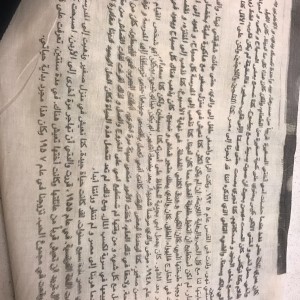Step 1:
It took me a while to choose who I wanted to interview, because at the start of this project i know that I wanted this piece to be personal and meaningful. For that reason, with lots of thought, i chose to interview my grandma about a story in her life that i had heard before, but i wanted to know more about.
Interview Summary:
- Born in 1935
- Jerusalem, Palestine
- She was the fourth child to her parents (baby sister came along later)
- Lived in a small house with her siblings and parents
- Father worked in textile store
- Father became ill and passed away
- War happened in 1948
- Mother emptied out textile store and sold them in secrecy for a living
- Moved to Egypt
- 1955 Moved to Jordan because her mother’s sister was living there
- 1957 Met my grandpa and married
Step 2:
The Script:
It was difficult to come up with the script. This was because it was hard for me to imagine the way the family would interact with one another and especially during that time. It was also hard to imagine because it was in a different language and I could not write that down in Arabic.
Step 3:
Immediately when my grandma told me she the reference to the textile part in the story, I knew that i wanted to use textile as my medium for this piece. I did know what i wanted to do with the textile exactly, but i knew i wanted to use it.
- I thought of painting a piece of my grandma’s family onto the piece of fabric. However after further thinking i thought that it would be difficult to paint on fabric and it also would not show the truthiness and pureness of the story if i were to paint to paint.
- My second idea was to do with photographs. I feel like photographs would show the true essence of the story, because not only do we actually see the time in which she was living in, but it seems more personal.
Step 4:
I collected photographs of my grandma, however I could only find 2 pictures of her back in Palestine as a child, which also seems interesting and explains a lot about the life back then.
Step 5:
I looked up some images of photo-transfer art, just so as I can get an idea of what i actually what my piece to look like or in which direction i would want my piece to go.
After finding some inspiration images of photo transfer online, i realized how text was almost incorporated in every piece and since it was a graphic narrative, i thought that i would also include my grandmas story on the piece itself. And to make it more relatable, i thought that writing the story in Arabic would be more personal and more aesthetically suitable with the piece itself.
Step 6:
The story writing both English and Arabic.
Step 7:
I chose to include 5 go the photos that best describe her life through the story. And so i printed them and chose the position of each picture. However after i actually transferred them onto the piece of fabric, i realized that there could have been space for one more picture in order to balance out the composition.
I did not find any difficulty with the transfer of the photos. It worked out very well and gave the old washed out effect that wanted.
As for the text, i also initially wanted to have it frame the images in Arabic, with just certain quotes of what my grandma said throughout the interview. However, after discussion with my professor and establishing that i would have to include the full story. So i chose to include the story under the text in separated paragraphs, which i feel also adds to the old/ worn-out effect.
The transferring of the text was not as smooth as the transfer of the images was. Because of the process of having to press down the fabric and go over it with a spoon, the text did not remain in place resulting in overlapping which may affect the clarity of the piece.













